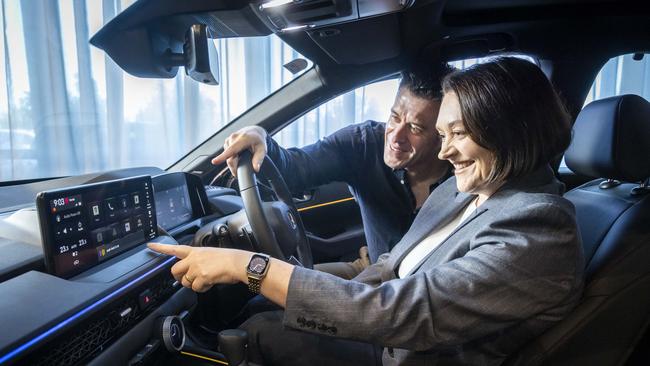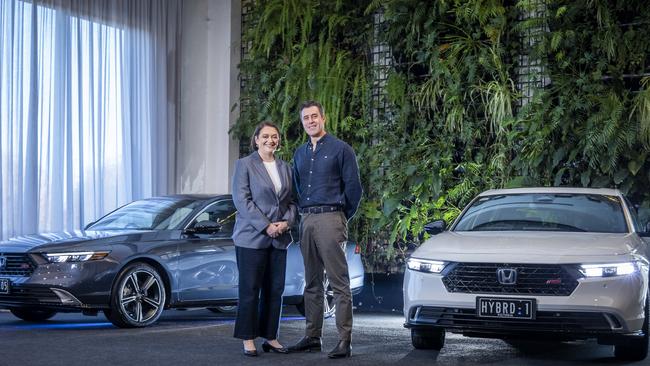‘Big smartphones on wheels’: how Honda and Telstra are making cars safer
Drivers will no longer need to travel with mobile phones after Honda and Telstra struck a new partnership to make cars smarter and safer.

Honda has partnered with Telstra as the $2.3 trillion battle for the dashboard heats up, turning cars effectively into giant smartphones on wheels in a move to make Australians roads safer and motoring more enjoyable.
Telstra SIM cards will be installed in new Honda Accord models, allowing connection to Google’s range of apps – from navigation to audio streaming – without needing a phone. Telstra has a similar agreement with Tesla.
The partnership is part of a shift in motoring, whereby the focus is not solely on how a vehicle drives but also the cabin experience. It’s a market estimated to be worth $US1.5 trillion ($2.3 trillion) and has pitted automakers and tech giants against each other as they contest the last unconquered screen: your car dashboard.
But the enhanced connectivity does not stop there. The technology is envisaged to eventually allow cars to “talk’ to each other like on a mesh network, improving traffic congestion and safety.
For now, Honda says the Telstra partnership will improve vehicle performance via collecting a car’s telemetry data, analysing engine wear, fuel efficiency and environmental conditions. The Japanese auto giant says this will provide tailored maintenance, with the car serviced based on how it’s driven.
But the biggest feature is safety. Like an Apple Watch, Honda Australia vice president Carolyn McMahon said the car will be able to detect when it’s in a crash and call emergency services.
“If the call centre representative cannot contact the customer, emergency services are deployed to the vehicle’s location – this service provides additional comfort to family members and customers, knowing that someone is always looking out for them,” Ms McMahon said.
“This is just another way in which we’re making the Honda customer experience safer and more enjoyable.”
Customers will access the service as part of a complimentary 5-year Honda Connect subscription.
Car makers are viewing subscription services as a way to keep customers sticky and fuel profits beyond the showroom floor. Tesla boss Elon Musk has said “technically we could sell for zero profit for now and then yield actually tremendous economics in the future through autonomy” and other subscription services.

For Honda, Ms McMahon said it was about strengthening the company’s competitive advantage.
“Over the last 24-months, we’ve worked collaboratively with Telstra to bring the next generation of in-car connectivity to Australians.
“It makes the technology more intuitive and simpler to use, meaning you don’t even need your phone to access the Google built-in features. This new in-car technology is just one small element of what makes the Honda ownership experience great value and a competitive advantage against the rest.”
Telstra industry executive Jon Young Flores said partnership was scratching the surface about enhanced in-car connectivity’s capabilities.
“I’ve got 14 year old twins, they’re going to be driving soon. If you lend them the car, you can actually geo tag the car so they start getting an annoying beep if they go too far,” Mr Young Flores said.
“If they’re on the highway and going above a certain speed limit, you can get a notification and they get an annoying beep until they slow the car down. So it’s kind of really changing the experience of what owning a car is like. And for us to be able to create that enabling infrastructure to be able to make it happen is actually really exciting.”
Mr Young Flores said Telstra was also trialling how the technology could be applied to streamline the trucking industry and improve the amenity of communities on major transport routes.
“We’ve been doing a lot of policy work with government, but mostly focused on heavy haul logistics and the big trucks that go up and down the east coast, and especially on the west coast for mining towns.
“Imagine a typical small town in the middle of the west, three red lights, and it’s a route for these big trucks that are just carrying heavy tonnage under their big diesel consumers. What happens if the telematics equipment on that car sends a signal to the red lights in that town and turns them all green so that it doesn’t have to stop?
“That not stopping is so beneficial to the town because you don’t get the diesel engines slowing down and having to start up. And that is a little bit linked to what the future holds.”
In coming years, Mr Young Flores also envisaged cars to “truly start talking to each other in kind of like a mesh network”.
“It really isn’t that far off now because the foundational infrastructure of these cars can open up conversations to them and that’s what gets us excited.”




To join the conversation, please log in. Don't have an account? Register
Join the conversation, you are commenting as Logout